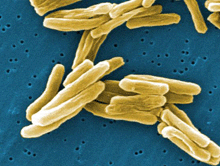Research Matters
December 8, 2008 Experimental Drug Destroys TB Bacteria From WithinScientists have discovered how an experimental drug unleashes its destructive force inside the bacteria that cause tuberculosis (TB). The finding could help scientists develop new approaches for combating dormant TB infections, which are especially difficult to treat. The research may ultimately lead to improved drugs against other bacteria as well.  Mycobacterium tuberculosis, the bacteria that cause tuberculosis. Image courtesy of Janice Carr, Centers for Disease Control and Prevention.
One-third of the world’s population, or more than 2 billion people, is infected with Mycobacterium tuberculosis, the bacterium that causes TB. Most of these infections are dormant, meaning the bacteria are alive but not actively reproducing. Because many strains of TB bacteria have become drug-resistant, and no current drugs are specifically targeted to dormant infections, scientists are continuing to search for new therapeutic approaches. One promising candidate, an experimental drug called PA-824, is now being tested in clinical trials. PA-824 is known to destroy both actively dividing and dormant TB bacteria. However, its mechanism for killing dormant bacteria has been unclear. Dr. Clifton E. Barry, III and his colleagues at NIH’s National Institute of Allergy and Infectious Diseases (NIAID) collaborated with scientists from the Novartis Institute for Tropical Diseases in Singapore to uncover the details of how PA-824 combats TB bacteria. Their findings were published in the November 28, 2008, issue of Science. TB bacteria parasitize the body’s defense mechanisms by living in immune system cells called macrophages. Macrophages produce a highly reactive and toxic molecule called nitric oxide (NO) that helps kill the bacteria. However, not all the TB bacteria are eliminated, and the immune cells wall off the survivors in what are called granulomas. As a granuloma becomes bigger, it produces an environment where oxygen levels are low, shutting down the growth of TB and causing it to go dormant. Dr. Barry and his collaborators discovered that the drug PA-824 works by releasing NO inside the TB bacterium itself. Through a series of experiments, they showed that PA-824 interacts with bacterial enzymes to produce 3 primary metabolites, the major one being des-nitroimidazole (des-nitro). The process releases several reactive and toxic nitrogen species, including NO. “This highly reactive molecule is akin to a bomb blast that kills the bacteria from within,” Dr. Barry says. The researchers found that higher levels of the metabolite des-nitro correlated with more bacterial killing under low-oxygen conditions. The toxic nitrogen byproducts of des-nitro production strike at the Achilles’ heel of the TB bacterium during low oxygen conditions, shutting down its ability to produce energy. PA-824 was originally designed to work best under oxygenated conditions. With this new understanding of how PA-824 works in a low-oxygen environment, Dr. Barry says, scientists can design drugs with a chemical structure similar to PA-824 but optimized to produce more des-nitro under low-oxygen conditions. Related Links:
Gene Activity Can Predict Survival Rates of Patients with Lymphoma Gut Microbiomes Differ Between Obese and Lean People Experimental Drug Destroys TB Bacteria From Within This page was last updated
December 8, 2008
.
|



